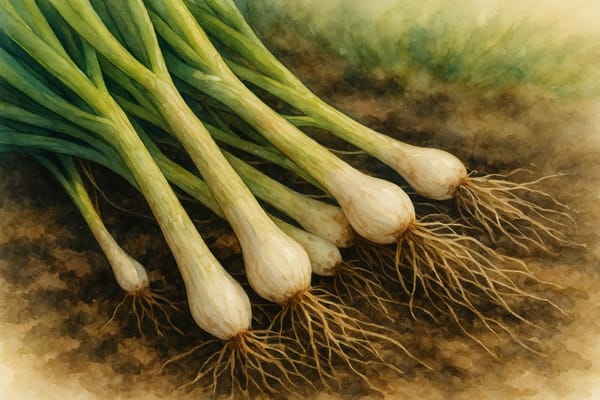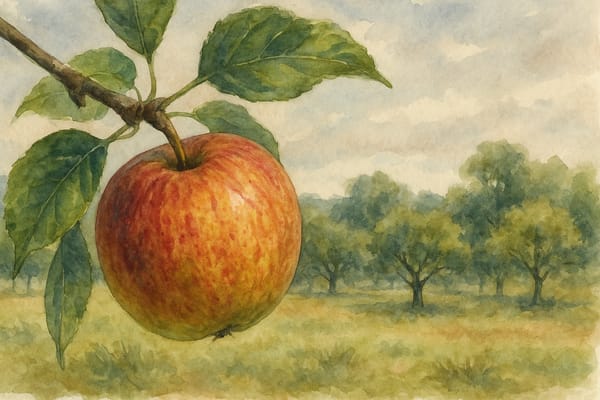There’s something deeply satisfying about harvesting a handful of spring onions just moments before you scatter them into a sizzling pan or crisp summer salad. Their clean white stems and upright green tops carry both the freshness of the garden and a quietly dependable charm—unfussy, versatile, and ready to grow almost anywhere. Among them, the White Lisbon variety has long been a favourite in Cornish kitchen gardens, prized for its vigour, sweet flavour, and ability to span the seasons.
A Hardy Staple of the Productive Plot
White Lisbon spring onions (Allium cepa) are what seasoned gardeners might call “a banker crop”—a sure and steady grower that rarely disappoints. In Cornwall’s temperate climate, they thrive whether tucked between rows of slower vegetables, sown into neat borders, or sprinkled into a wide pot on a sunny patio. They ask very little but reward with great abundance.
Fast to mature—ready in just six to eight weeks—they’re especially useful for gardeners looking to maximise their space or keep a small supply of fresh pickings through the warmer months. Their shallow roots and upright growth make them ideal for containers and raised beds, and their speed means they can be slipped into empty corners after early crops or used as a ‘catch crop’ to fill space while other plants take their time.
Soil & Sowing: The Gentle Start
White Lisbon prefers a well-prepared, fertile soil with good drainage—something loose, crumbly, and enriched with compost the autumn before planting. In heavier soils, adding sharp sand or organic matter will help create the fine tilth these little seeds favour. A neutral pH between 6.0 and 7.0 keeps them happiest, and it’s best to avoid freshly manured beds, which can encourage too much leaf and not enough bulb.
Seeds can be sown directly into the soil from February right through to August, and even in September for overwintering in milder spots. For a steady supply, sowing every two to four weeks is ideal. Make shallow drills about 1–1.5cm deep, spaced 10–15cm apart, and scatter the seeds thinly. There's often no need to thin unless you’ve been a bit generous—though 2–3cm spacing will help them develop well-shaped, straight stems.
In containers, the process is similar: use a peat-free compost with added grit for drainage, keep the sowing shallow and even, and water gently but consistently.
Care Through the Seasons
As with many quick-growing crops, spring onions are most vulnerable when young. Keep the bed or pot weed-free—these slender stems don’t like competition. Cloches or horticultural fleece can help early sowings through cold spells and deter pests like onion fly or allium leaf miner. Slugs may show interest in moist weather, so keep a watchful eye during wet weeks.
Consistent watering is important, especially during dry spells. The roots are shallow, so they’ll suffer quickly if the soil dries out or becomes waterlogged. A mulch of fine compost or grass clippings can help retain moisture and suppress weeds.
White Lisbon doesn’t ask for much in the way of feeding, especially if your soil was well-prepared. But if growth seems slow, a diluted liquid feed with a little potash can give a gentle boost.
Harvesting & Using
You’ll know they’re ready when the stems reach about pencil thickness—crisp, white, and clean. This is usually about 6–8 weeks from sowing. Lift gently by hand, or use a small fork if your soil is firm. Harvesting regularly not only keeps your supply going but helps younger seedlings catch up in size.
In Cornish gardens, a spring sowing can keep producing through summer, while an autumn sowing will offer one of the earliest delights in spring—a welcome taste of green when the rest of the plot is still stirring from winter. Their mildness means they’re perfect eaten raw, sliced into potato salads, grain bowls, or laid gently across grilled mackerel or new season lamb.
A Garden Constant
Whether you have a sprawling productive garden or a few pots along a slate-topped wall, White Lisbon fits right in. It’s one of those humble crops that connects us to the everyday rhythm of the garden—a quiet but essential thread between seasons. You sow, water, watch—and in just a few short weeks, the reward is there in your hand: a fresh reminder of what’s possible with even the smallest space and a packet of seeds.











